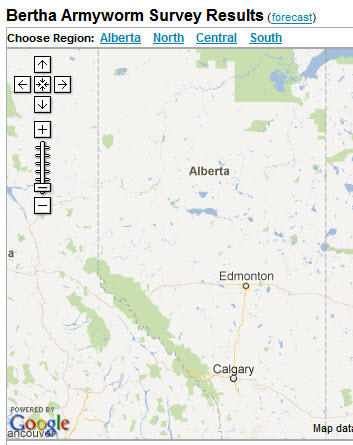
| |
2012 Bertha Armyworm Forecast | |
| |
|
|
| |
|
|
| | Follow this link to return to the Alberta Insect Pest Monitoring Network home page.
.
| Bertha armyworm (Mamestra configurata) was monitored in 2011 using a network of pheromone-baited traps placed in 146 locations throughout Alberta. Pheromone traps are used to determine the density and distribution of moths. This network of pheromone traps is organized by AARD but individual traps are managed by a wide range of cooperators. Without dedicated and willing cooperators such a comprehensive monitoring system would not be possible. Overall numbers of BAW moths remained below the first alert level but many trap catches were elevated over the previous year. The bottom line is a real potential for BAW problems exists in 2012. The 2012 bertha armyworm survey will be very important in determining the risk.
Bertha armyworm 2012 survey results will be coming in mid June when the new survey season starts. Potential damage from bertha armyworm may be more or less severe than suggested by the moth count data depending on weather and crop conditions and localized population dynamics. An insecticide application is recommended when the larval numbers meet the economic threshold . For pesticide options visit Alberta Agriculture's Pesticide Selector. |  |
Bertha armyworm populations are normally kept in check by such factors as weather and natural enemies. Generally parasitism rates of 50 - 60 percent in bertha larval populations have indicated the end of a local outbreak. Cumulative moth counts in traps during June and July help determine the level of risk for August. The results from 2011 suggest that bertha armyworm has been through the low part of the cycle and may be making a recovery.
Eight locations in 2011 were in the first warning level of Uncertain. These sites were over a wide range from Fort Vermillion through central Alberta and as far south as Vulcan. Control operations were required in the northern Peace region and in several fields in central Alberta. Cumulative moth counts in traps during June and July of 2012 will give us a much better evaluation of the population and therefore the risk in August.
The bertha armyworm forecasting program for Alberta has been conducted since 1995. Provincial government personnel, industry agronomists, Applied Research Associations, Agricultural Fieldmen and cooperating growers maintain the pheromone trap network. The cumulative moth count maps are maintained by Alberta Agriculture and Rural Development.
During the monitoring season and until January the map is a Google map which means you can move around, zoom in and click on the individual balloons. By clicking on a balloon it will show the organization that looked after that trap, what municipality the trap is in, the weekly count and cumulative count (all counts displayed are the average between the two traps at a site). During the trapping season the information is updated as the entries are made into the data collection website. The resolution is not accurate enough to pinpoint the exact location of individual traps.
The objective of the monitoring is to heighten the awareness of canola producers to the damage potential of bertha armyworm. Forecast maps DO NOT replace field scouting. No field should be treated for bertha armyworm control without proper field scouting. Moth catches indicate the potential for damage but the actual populations must be assessed.
| Cumulative moth catch | Risk Level | Interpretation |
| 0 to 300 | Low | Infestations are unlikely to be widespread, but fields should be inspected for signs of insects or damage. |
| 300 to 900 | Uncertain | Infestations may not be widespread, but fields that were particularly attractive to egg-laying females could be infested. Check your fields. |
| 900 to 1200 | Moderate | Infestations likely, canola fields should be sampled regularly for larvae and for evidence of damage. |
| 1200+ | High | Infestations very likely, canola fields should be sampled frequently for larvae and for evidence of damage. |
Alberta Insect Pest Monitoring Network 2011 Annual Report
For more information on this insect and its management contact the Ag-Info Centre at 310-FARM (3276) or bugs.r.us@gov.ab.ca |
|
| |
|
|
| |
For more information about the content of this document, contact Scott Meers.
This document is maintained by Shelley Barkley.
This information published to the web on December 13, 2011.
Last Reviewed/Revised on January 24, 2013.
|
|